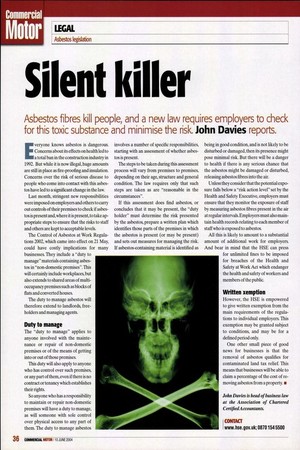Si ent ki ler
Page 30

If you've noticed an error in this article please click here to report it so we can fix it.
Asbestos fibres kill people, and a new law requires employers to check
for this toxic substance and minimise the risk. John Davies reports.
Everyone knows asbestos is dangerous. Concerns about its effects on health led to a total ban in the construction industry in 1992. But while it is now illegal, huge amounts are still in place as fire-proofing and insulation. Concerns over the risk of serious disease to people who come into contact with this asbestos have led to a significant change in the law.
Everyone knows asbestos is dangerous. Concerns about its effects on health led to a total ban in the construction industry in 1992. But while it is now illegal, huge amounts are still in place as fire-proofing and insulation. Concerns over the risk of serious disease to people who come into contact with this asbestos have led to a significant change in the law.
Everyone knows asbestos is dangerous. Concerns about its effects on health led to a total ban in the construction industry in 1992. But while it is now illegal, huge amounts are still in place as fire-proofing and insulation. Concerns over the risk of serious disease to people who come into contact with this asbestos have led to a significant change in the law.
Last month, stringent new responsibilities were imposed on employers and others to carry out controls of their premises to check if asbestos is present and, where it is present, to take appropriate steps to ensure that the risks to staff and others are kept to acceptable levels.
The Control of Asbestos at Work Regulations 2002, which came into effect on 21 May, could have costly implications for many businesses. They include a "duty to manage" materials containing asbestos in "non-domestic premises". This will certainly include workplaces, but also extends to shared areas of multioccupancy premises such as blocks of flats and converted houses.
The Control of Asbestos at Work Regulations 2002, which came into effect on 21 May, could have costly implications for many businesses. They include a "duty to manage" materials containing asbestos in "non-domestic premises". This will certainly include workplaces, but also extends to shared areas of multioccupancy premises such as blocks of flats and converted houses.
The duty to manage asbestos will therefore extend to landlords, freeholders and managing agents.
Duty to manage
The "duty to manage" applies to anyone involved with the maintenance or repair of non-domestic premises or of the means of getting into or out of those premises.
This duty will also apply to anyone who has control over such premises, or any part of them, even if there is no contract or tenancy which establishes their rights. So anyone who has a responsibility to maintain or repair non-domestic premises will have a duty to manage, as will someone with sole control over physical access to any part of them. The duty to manage asbestos
involves a number of specific responsibilities, starting with an assessment of whether asbestos is present.
The steps to be taken during this assessment process will vary from premises to premises, depending on their age, structure and general condition. The law requires only that such steps are taken as are "reasonable in the circumstances". If this assessment does find asbestos, or concludes that it may be present, the "duty holder" must determine the risk presented by the asbestos, prepare a written plan which identifies those parts of the premises in which the asbestos is present (or may be present) and sets out measures for managing the risk. If asbestos-containing material is identified as
being in good condition, and is not likely to be disturbed or damaged, then its presence might pose minimal risk. But there will be a danger to health if there is any serious chance that the asbestos might be damaged or disturbed, releasing asbestos fibres into the air.
Unless they consider that the potential exposure falls below a "risk action level" set by the Health and Safety Executive, employers must ensure that they monitor the exposure of staff by measuring asbestos fibres present in the air at regular intervals. Employers must also maintain health records relating to each member of staff who is exposed to asbestos.
All this is likely to amount to a substantial amount of additional work for employers. And bear in mind that the HSE can press for unlimited fines to be imposed for breaches of the Health and Safety at Work Act which endanger the health and safety of workers and members of the public.
All this is likely to amount to a substantial amount of additional work for employers. And bear in mind that the HSE can press for unlimited fines to be imposed for breaches of the Health and Safety at Work Act which endanger the health and safety of workers and members of the public.
Written xemption
However, the HSE is empowered to give written exemption from the main requirements of the regulations to individual employers. This exemption may be granted subject to conditions, and may be for a defined period only.
One other small piece of good news for businesses is that the removal of asbestos qualifies for contaminated land tax relief. This means that businesses will be able to claim a percentage of the cost of removing asbestos from a property.
John Davies is head of business law at the Association of Chartered Certified Accountants.
























































































































































































